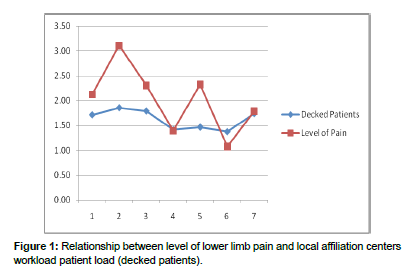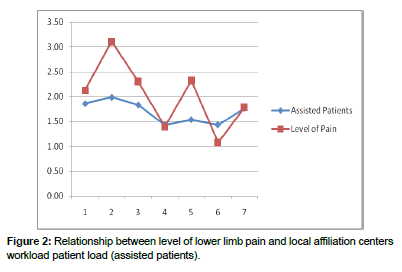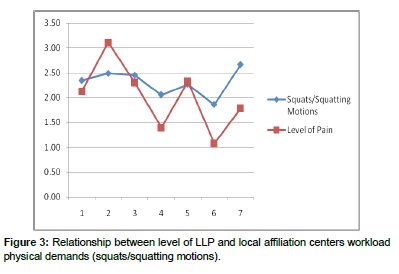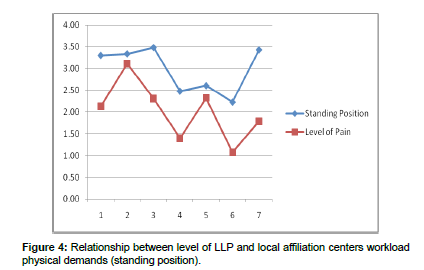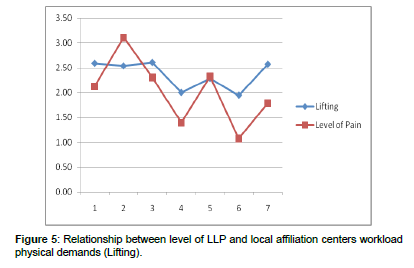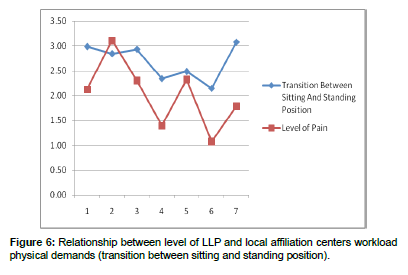Local Internship Affiliation Center Workload and Lower Limb Pain among Physical Therapy interns in Selected University: Correlational Study
Received: 03-Jul-2023 / Manuscript No. jnp-23-104904 / Editor assigned: 05-Jul-2023 / PreQC No. jnp-23-104904 (PQ) / Reviewed: 19-Jul-2023 / QC No. jnp-23-104904 / Revised: 24-Jul-2023 / Manuscript No. jnp-23-104904 (R) / Published Date: 31-Jul-2023 DOI: 10.4172/2165-7025.1000607
Abstract
Introduction: Internships are an essential part of educational programs to provide hands-on experience to students. Internships may last anywhere from six months to two years. Eight hours of duty for five consecutive days, handling various patients and treating them in a different environment is a big task for interns. Musculoskeletal pain is highly prevalent in the healthcare industry frequently affecting healthcare workers including nurses, medical technologists, and physical therapists (PT). Low back pain accounted for the most common site of pain experienced by PT while hip and thigh were the least common, and thus the most under researched. Due to this, the researchers hoped to identify whether or not the internship workload contributes to the lower limb pain of the Physical Therapy Interns in selected higher education institution (HEI) AY 2022-2023. The findings of the study will serve as the baseline to those who wish to conduct similar studies.
Methods: This study used a descriptive-correlational design which allowed the researchers to gather information, measure and explain the association between the variables. Respondents were the Physical Therapy Interns of selected HEI AY 2022-2023. The data was gathered through google forms which were emailed to the respondents. The researchers used a self-made questionnaire that underwent a Cronbach-Alpha Coefficient for reliability testing and Lawshe Content Validity testing for the questionnaire.
Results: The results have shown that there is a significant relationship between the level of lower limb pain and local affiliation center workload, however there is no relationship between level of lower limb pain and local affiliation center physical demands and types of interventions.
Discussion: The study concluded that the greater the patient load an intern has, the greater their risk of developing lower limb pain. As a result, the findings of this research is useful to the said benefactors to provide and/or suggest amelioration activities to prevent or lessen the occurrence of lower limb pain with regards to the said factors.
Keywords
Affiliation center workload; Physical therapy interns; Lower limb pain
Introduction
It is well recognized that musculoskeletal issues are highly prevalent in healthcare workers (HCW). But because there hasn't been much research on lower limb issues, we still don't know much about lower limb pain (LLP). A few studies show that working populations like nurses, assembly line employees, industrial workers, and service and sales personnel experience problems in their lower limbs that are related to their jobs. In these investigations, the prevalence of lower limb pain ranged from 16% to 50%. Lower limb pain has been linked to a number of physical risk factors, including standing, regular lifting, and heavy pushing or pulling, in addition to psychological ones (Yusoff et al., 2017). It is a serious issue because it has a strong negative impact on both employees and their organizations. It was discovered that among the categories with a high prevalence of musculoskeletal disorders (MSD) were HCW. A study conducted by Yusoff, et al (2017) has shown that the mean prevalence of MSD among nurses was reported to be higher than 70% in a systematic review of the subject. Even while the majority of HCW studies have focused on nurses, other healthcare personnel have been found to have a similarly high prevalence of MSD [1]. The axial region (neck and low back) and both upper limbs were discovered to be the most often afflicted anatomical regions for MSD in HCW. MSD are typically caused by a variety of factors including physical and ergonomic factors. It typically affects those workers who engage in heavy lifting with awkward postures, prolonged standing, walking, and repetitive movements. PT from all across the world regularly describe having musculoskeletal pain while at work (Desai, et al, 2020). PT typically examine a patient's medical history, patient’s strength, balance, and coordination as well as the cardiovascular conditions and motor functions. Similarly, during their internship, physical therapy interns often are put across lengthy hours of activities that demand strenuous physical activities. As a result, musculoskeletal problems such as lower limb pain may occur.
Present day internships are distant relatives of 11th century apprenticeships in the guild system, where apprentices live with a master for a decade or more without payment. This continued until the Industrial Revolution in the 18th and 19th century where apprenticeship was replaced by vocational training in order to equip workers with skills required for factory work. Over the course of the 20th century this system evolved into the internships we know today, where students work at jobs to gain supervised practical experience as part of educational curriculums. Internships are an essential part of educational programs to provide hands-on experience to their students. It comprises a carefully monitored and evaluated service experience with intentional learning objectives where students can reflect on what they are learning throughout the experience. Internships may last anywhere from six months to two years. Despite being part of an educational program, internship training also aims to hone a student’s skills in their chosen field. Internship training allows for educational, career and personal development.
A physical therapy student intern typically reviews the patient's medical history, strength, range of motion, coordination, balance, posture, muscular performance, breathing, and motor function of the patient are tested and measured. They assess a patient's independence and assist with their reintegration into society or the workplace following an illness or accident. They create a therapy strategy, its goal, and other details in a treatment plan and the anticipated results [2,3]. Interns are frequently required to perform exhausting tasks for extended periods of time such as standing, walking, and performing various tasks while providing physical therapy treatment sessions. This could lead to harmful physiological changes that cause lower limb pain, among other things. If persistent pain or discomfort is disregarded, the resulting physiological damage may result in an injury. This is relevant because studies have reported that 16% of physical therapists first experienced musculoskeletal pain while they were students. (Manasi and Jain, 2020).
However, very little studies have looked at the frequency of lower limb pain in PT, especially among physical therapy interns, notably in the Philippines. The lack of research on the relationship of LLP and affiliation center workload may escalate into a more serious condition especially if not addressed. It was also taken into consideration that most of the interns who have undergone and are undergoing the local affiliation center rotation experiences lower limb pain, the researchers were curious why it was the second most common area of pain after lower back pain being the first. Thus, the researchers decided to commit with the intention of knowing whether the LLP that interns experienced was related to their local affiliation center workload. Without the data and information gathered, this could lead to a decreased level of performance of the interns who are experiencing LLP that are currently rotating to the different local affiliation centers. The main objective of this study was to identify the presence and number of interns that are experiencing LLP and its relationship with the patient workload and physical work factors of the local affiliation centers.
Method s
This study used a descriptive quantitative design, specifically a descriptive correlational design, to create a snapshot of the current situation and identify the relationship between local affiliation workload and LLP among physical therapy interns in selected HEI. All physical therapy interns of the above-mentioned institution constituted as the participants for this study [4]. For the inclusion criteria: student must be a legitimate intern belonging to the class of 2022-2023, must have undergone and is undergoing at least one of the internship rotations in the local affiliation center. Students were excluded in the study using the following criteria: have a history of existing medical conditions, severe pain, and dysfunction on the lower limb prior to internship, and who refused to participate in the study. For sampling method, total enumeration was utilized. Several steps were undertaken to gather the necessary data required for the study. Data was collected via the implementation of the researcher-made instruments that were delivered using Google Forms platform. The survey questionnaire was divided into three sections. The first section was used to gather personal information about the respondents which include the age, sex, local affiliation centers the participants rotated in, and possible comorbidities that the respondent may have. The second section was for gathering sociodemographic information which include the patient load, frequency of physical demands, and type of therapy intervention. Five-point Likert scale was employed in this study. The last part of the instrument was intended for the participants to assessed the occurrence of LLP during their internship (Figures 1-3). The research instruments were face-validated and content validated by the panel of experts. Data for validation was then treated using Lawshe’s Content Validity Ratio and Content Validity Index [5]. Results revealed that the questionnaire was indeed valid. The instruments were also tested for its reliability using the Cronbach’s alpha. Results also revealed that the questionnaire is good and acceptable. Pilot testing was also conducted before the actual implementation of the research instruments using population similar to physical therapy interns (nursing interns).
This study involved 71 participants who were eligible to participate in the investigation. However, 18 participants were excluded from the study (15 participants based on the exclusion criteria and 3 participants did not answer the questionnaire). Overall, the responses gathered were from 53 participants. Data collected was transcribed, coded, and extracted with the use of MS Excel. Each individual response was translated into its corresponding numerical value according to the Likert scale. The mean was computed to determine the representative level of pain and local affiliation center workloads experienced by the participants. The Pearson product-moment correlation coefficient was employed to measure the intensity and direction of association between the local affiliation center workload and LLP. The study was reviewed and approved by the Silliman University Research Ethics Committee. All the participants gave their consent in participating in this study by submitting the signed informed consent letter containing the benefits, rights, and significance of the study [6].
The table presents the level of LLP experienced by Physical Therapy Interns in selected HEI in different Local Affiliation Center Workload. As it reveals, the highest level of pain experienced is in moderate pain with a weighted mean of 3.11, it is experienced while rotating at NOPH. Second, is experienced in VALENCIA CBR with a weighted mean of 2.32 and with a verbal interpretation of mild pain (Table 1).
| Level of Lower Limb Pain | Weighted Mean | Verbal Interpretation | Rank |
|---|---|---|---|
| Average peak of lower limb pain experienced while rotating in SUMC | 2.13 | Mild Pain | 4 |
| Average peak of lower limb pain experienced while rotating in NOPH | 3.11 | Moderate Pain | 1 |
| Average peak of lower limb pain experienced while rotating in ACEDD | 2.30 | Mild Pain | 3 |
| Average peak of lower limb pain experienced while rotating in SUMMC CBR | 1.39 | Mild Pain | 6 |
| Average peak of lower limb pain experienced while rotating in VALENCIA CBR | 2.32 | Mild Pain | 2 |
| Average peak of lower limb pain experienced while rotating in VALENCIA OPD | 1.07 | Mild Pain | 7 |
| Average peak of lower limb pain experienced while rotating in IRSFC | 1.79 | Mild Pain | 5 |
| Composite Mean | 2.02 | Mild Pain | |
| Note: The centers are referred to as follows in the succeeding pages: SUMC: Center 1; NOPH: Center 2; ACEDD: Center 3; SUMMC CBR: Center 4; Valencia CBR: Center 5; Valencia OPD: Center 6; IRSFC: Center 7 | |||
As the table shows, the general weighted mean of the LLP experienced is 2.02 and with a verbal interpretation of mild pain. We can say that most of the Physical Therapy Interns of selected HEI experienced a mild pain in their lower limb while rotating with different local affiliation center workload.
Relationship between level of lower limb pain and local affiliation center workload patient load
Presents the correlation between the level of LLP and local affiliation centers workload in terms of patient load. As shown, the correlation value with the decked patients is 0.756 which denotes a high correlation, while the t-value of 2.583 is greater than the t-tabular of 2.571 using the significance level of 0.05 and with a degree of freedom of 5 resulting in significance [7]. While with the assisted patients, it shows that the correlation value is 0.802 which also denotes a high correlation, and the t-value of 2.997 is greater than the t-tabular of 2.571 using the significance level of 0.05 and with a degree of freedom of 5 resulting to significant correlation (Table 2).
| Patient Load | r-value | Description | t-value | t-tabular | Interpretation | Decision |
|---|---|---|---|---|---|---|
| Decked Patients | 0.756 | High Correlation | 2.583 | 2.571 | Significant | Rejected |
| Assistive Patients | 0.802 | High Correlation | 2.997 | 2.571 | Significant | Rejected |
| DF – 5 LS – 0.05 |
||||||
It means that there is a significant relationship between the LLP and local affiliation centers' workload in terms of patient load. This supports the study of Kakarpathi et al. (2021) and Chen et al. (2022) who concluded that increased patients seen per day may also increase the risk of developing LLP. The number of patients that an intern treats per day have a direct relationship with lower limb pain. Moreover, having more assisted patients have a direct relationship with LLP compared to having more decked patients. This is contrary to what is expected since treating decked patients is more physically demanding than assisting a treatment [8].
Relationship between level of lower limb pain and local affiliation center workload physical demands
As the result reveals, it means that there is no significant relationship between the level of LLP and local affiliation centers' workload in terms of physical demands. This data shows that repetitive activities, sustained postures and other HCW tasks may not be the sole cause of LLP among healthcare workers and student interns as mentioned by previous studies . More physical demands does not necessarily equate to an increased risk of LLP. However, between the factors mentioned above, repetitive lifting has a high correlation with LLP, which means that repetitive lifting in a day can be a factor for LLP. Further research is needed to identify other possible contributing factors for the LLP that interns experience. There may also be external factors that caused the interns’ LLP outside of the workload demands of the local affiliation centers. However, it can be noted that Center 2 had the second highest frequency for carrying which support the high correlation between repetitive carrying and LLP .
Relationship between level of LLP and local affiliation centers workload
Therapy intervention
The correlation between the level of LLP and local affiliation centers workload in terms of therapy intervention. As shown, using the significance level of 0.05 and a degree of freedom of 5, the t-tabular is equal to 2.571. The correlation value in active intervention is 0.195 which denotes a negligible correlation, and in passive intervention is 0.600 that denotes a moderate correlation. The computed t-value of active and passive intervention are 0.445 and 1.667 respectively thus resulting in insignificant.
As the result reveals, it means that there is no significant relationship between the level of LLP and local affiliation centers workload in terms of therapy intervention. This goes against Ezzatvar et al (2021) and Yusoff et al. (2017) wherein they claimed that high workloads and frequent health care tasks would increase the risk of LLP. It can be noted that active interventions have a negligible correlation between LLP compared to moderate correlation of passive interventions (Figures 4-6). This was expected since passive interventions are more physically demanding than active interventions where the patient performs the exercises.
Discussion
Based on the results of the data gathered, there is a significant relationship between the level of LLP and local affiliation center workload among interns in terms of patient load. The study concluded that the number of patient load have a greater correlation with LLP as well as the number of assisted patients have greater correlation with LLP than the number of decked patients. On the other hand, there is no significant relationship between the level of pain and local affiliation centers’ workload in terms of physical demands and types of interventions. As a result, the notable findings of this research can be of help to the said benefactors to provide and/or suggest amelioration activities to prevent or lessen the occurrence of LLP with regards to the said factors. Moreover, as the results of the study go against the studies who claimed that there is a correlation between repetitive motions, sustained postures, higher frequency of healthcare tasks LLP among healthcare workers. It is a new finding suggesting that there may be other factors to consider for the occurrence of LLP among healthcare workers and even specifically in the field of Physical Therapy. In line with the data gathered, decked and assisted patients have greater relationships in contributing to the LLP of the PT student interns, thus we recommend that: Limitations on the number of assisted patient loads should be imposed in order to reduce the number of patients handled per day per intern. Patients should also be equally decked among interns [9-14]. Moreover, local affiliation centers who have a greater patient census should be allotted more interns compared to those with lesser patient loads to ensure that interns will have similar patient loads. These steps will decrease the risk of LLP that may be caused by increased patient loads.
The researchers suggest that the different factors could be of another external source aside from the internship rotation demands itself. In line with this, a future research study should examine those probable external factors to expand the scope and to be able to perhaps recommend a better coping mechanism in terms of alleviating the LLP acquired during, after, and/or throughout the internship. Moreover, future researchers could focus on one of the local affiliation centers and explore other possible factors for the occurrence LLP based on the specifics demands of the center. Since this study only delt with the local affiliation center, future researchers could also widen the scope to include affiliation centers outside of Negros Oriental
References
- Kenneth DK, Stephen JL, Joan SV, Cynthia JB (2015) Solving 21st Century Problems in Biological Inorganic Chemistry Using Synthetic Models. Acc Chem Res 48: 2659-2660.
- Hannah H, Gerlinde G, Christian GH (2016) Electrophoretic separation techniques and their hyphenation to mass spectrometry in biological inorganic chemistry. Electrophoresis 37: 959-972.
- Williams DR (2000) Chemical speciation applied to bio-inorganic chemistry. J Inorg Biochem 79: 275-283.
- David RB, Henryk K (2004) Biological inorganic and bioinorganic chemistry of neurodegeneration based on prion and Alzheimer diseases. Dalton Trans 7: 1907-1917.
- Christine N (2014) A refuge for inorganic chemistry: Bunsen's Heidelberg laboratory. Ambix 61: 115-140.
- Diego LM, Enrico R (2016) Editorial (Thematic Issue: Medicinal Inorganic Chemistry: Identification of New Targets in Drug Discovery). Curr Top Med Chem 16: 3019-3020.
- Kautto J, Realff MJ, Ragauskas AJ, Kässi T (2014)Economic Analysis of an Organosolv Process for Bioethanol Production. Bio Resources 9:6041-6072.
- Nguyen TTH, Kikuchi Y, Noda M, Hirao M (2015)A New Approach for the Design and Assessment of Bio-based Chemical Processes toward Sustainability. Ind Eng Chem Res 54: 5494-5504.
- Rossetti I, Lasso J, Compagnoni M, Guido G De (2015) H2 Production from Bioethanol and its Use in Fuel-Cells. ChemEng Trans 43: 229-234.
- Vivian WWY (2015) Inorganic Chemistry: A Prestigious History and a Bright Future. Angew Chem Int Ed Engl 54: 8304-8305.
- Jose LMF, Edgar LL, Emma A, Lena RA, Angelo F, et al. (2022) Bridging informatics and medicinal inorganic chemistry: Toward a database of metallodrugs and metallodrug candidates. Drug Discov Today 27: 1420-1430.
- Kenneth DK, Stephen JL, Joan SV, Cynthia JB (2015) Solving 21st Century Problems in Biological Inorganic Chemistry Using Synthetic Models. Acc Chem Res 48: 2659-2660.
- Hannah H, Gerlinde G, Christian GH (2016) Electrophoretic separation techniques and their hyphenation to mass spectrometry in biological inorganic chemistry. Electrophoresis 37: 959-972.
- Williams DR (2000) Chemical speciation applied to bio-inorganic chemistry. J Inorg Biochem 79: 275-283.
Indexed at, Google Scholar, Crossref
Indexed at, Google Scholar, Crossref
Indexed at, Google Scholar, Crossref
Indexed at, Google Scholar, Crossref
Indexed at, Google Scholar, Crossref
Indexed at, Google Scholar, Crossref
Indexed at, Google Scholar, Crossref
Indexed at, Google Scholar, Crossref
Indexed at, Google Scholar, Crossref
Indexed at, Google Scholar, Crossref
Indexed at, Google Scholar, Crossref
Indexed at, Google Scholar, Crossref
Citation: Abarco MSB (2023) Local Internship Affiliation Center Workload and Lower Limb Pain among Physical Therapy interns in Selected University: Correlational Study. J Nov Physiother 13: 607. DOI: 10.4172/2165-7025.1000607
Copyright: © 2023 Abarco MSB. This is an open-access article distributed under the terms of the Creative Commons Attribution License, which permits unrestricted use, distribution, and reproduction in any medium, provided the original author and source are credited.
Select your language of interest to view the total content in your interested language
Share This Article
Recommended Journals
Open Access Journals
Article Tools
Article Usage
- Total views: 1483
- [From(publication date): 0-2023 - Nov 16, 2025]
- Breakdown by view type
- HTML page views: 1159
- PDF downloads: 324

